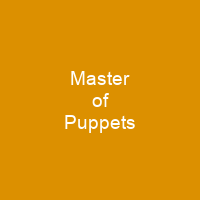Master of Puppets is the third studio album by American heavy metal band Metallica. It was released on March 3, 1986, by Elektra Records. Recorded in Denmark at Sweet Silence Studios with producer Flemming Rasmussen, it was the band’s last album to feature bassist Cliff Burton. It is widely considered to be one of the greatest and most influential heavy metal albums of all time.
About Master of Puppets in brief

The songwriting process started with guitar riffs, assembled and reassembled until they start to sound like a song. After that, the band came up with a song title and topic, and Hetfield wrote lyrics to match the title. The writing of all the songs except “Orion” and “The Thing That Should Not Be” was completed before the band arrived in Copenhagen, Denmark, for the recording. The recording took longer than the previous album because Metallica had a sense of perfectionism and had higher ambitions. With a reputation for drinking, the group stayed sober on recording days and developed a range of influence that went beyond that of contemporary hard rock and glam metal albums. They played the Monsters of Rock festival at Castle Donington, alongside Bon Jovi and Ratt to an audience of 70,000, during the summer of 1985. After parting with manager Jon Zazula, Metallica hired Q Prime executives Cliff Burnstein and Peter Mensch. They signed the group to an eight-album deal in the fall of 1984, halfway through the album’s promotional tour. The band was not satisfied with the acoustics of the American studios they considered, and decided to record in Ulrich’s native Denmark. Ulrich took drum lessons, and Hammett worked with Joe Satriani to learn how to record more efficiently. Ulrich was in talks with Rush’s bassist and vocalist Geddy Lee to produce the album, but the collaboration never materialized because of uncoordinated schedules.
You want to know more about Master of Puppets?
This page is based on the article Master of Puppets published in Wikipedia (as of Dec. 05, 2020) and was automatically summarized using artificial intelligence.







